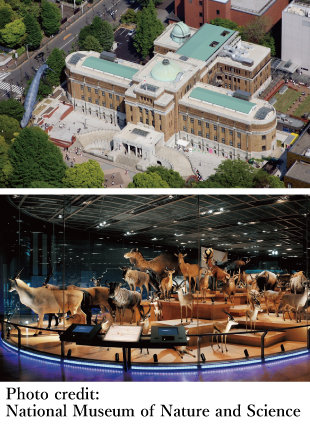Vol.13 Interview
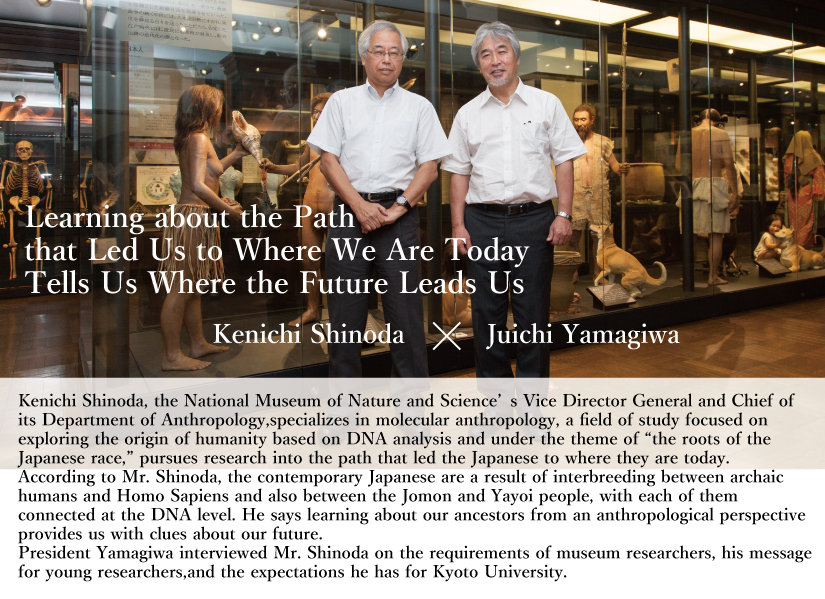
Kenichi Shinoda
Vice Director General and Chief of the Department of Anthropology
National Museum of Nature and Science
Born in Shizuoka Prefecture in 1955. Graduated from Kyoto University's Faculty of Science in 1979. Joined the National Museum of Nature and Science after having worked as an associate professor at Saga Medical School. Currently serves as the Museum's Vice Director General and concurrently Chief of its Department of Anthropology and also as President of the Anthropological Society of Nippon.
Specializes in molecular anthropology, a field of study focused on exploring the origin and evolution of humanity by analyzing the DNA of ancient human bones.
Pursues research into the origin of the Japanese race by analyzing DNA extracted from ancient human bones found in Japan and neighboring countries, as well as DNA research into the pedigrees and social structure of the indigenous peoples who lived in the Andes before the Spanish colonization of the Americas.
Has published the following: 1) Nihonjin ni natta sosentachi (Our Ancestors Who Became Japanese) from NHK Publishing, Inc.; 2) DNA de kataru nihonjin kigenron (Discussing the Origin of the Japanese Race Based on DNA) from Iwanami Shoten, Publishers; and 3) Edo no hone wa kataru - yomigaetta senkyoshi Sidotti no DNA (The Bones of Edo Speak - the Resurrected DNA of a Missionary Named Sidotti) from Iwanami Shoten, Publishers.
What changes have been made to existing human evolution scenarios and how do archaic humans and Homo Sapiens differ?
Yamagiwa I hear that your museum's special exhibition "Human Body - Challenge to Mystery" held from March to June 2018 was a big success.
Shinoda Yes, it was. We welcomed about 500,000 visitors. Instead of simply displaying our newest findings from human body research, the Museum based its exhibition on the two axes of history and achievements to introduce the past and present of human body research.
Yamagiwa The mystery of the human body and the origin of humanity have and will forever interest us. I hear that great advances in DNA analysis technology used in molecular anthropology for investigating the origin and evolution of humanity have enabled us to acquire high-precision information, bringing changes to existing human evolution scenarios.
Shinoda In the 21st century, the multiregional evolution hypothesis, which suggested that hominids who existed in regions across the globe evolved into modern humans, was replaced by the African origin of modern humans hypothesis, which states that all modern human species originated in Africa and then spread throughout the world.
Previously, a sharp discontinuity had been believed to exist between archaic humans, including the Neanderthals, and Homo Sapiens. However, findings made since 2010 have indicated substantial interbreeding. We now know that the genes of Homo Sapiens contain Neanderthal DNA.
Yamagiwa Now that we know there was interaction between Neanderthals and Homo Sapiens, do we know of any differences there may have been between their lifestyles and behavioral characteristics?
Shinoda That certainly is the key to finding out how they coexisted, but genetic information can only tell us the sequence of human evolution.
Yamagiwa Do we know of any advantages that Homo Sapiens had over Neanderthals?
Shinoda Complete genome sequencings of a couple of Neanderthals have identified genome sequences unique to Neanderthals. Differences have also been discovered in genes that express in the brain and also have to do with language. However, we do not know yet what to make of them.
To find out whether there were any other differences in their abilities, lifestyles, and behavioral characteristics, we may need approaches from fields other than molecular anthropology.
Learning about the path taken by our ancestors provides us with clues about our future
Yamagiwa The origin of the Japanese race, on which you are an expert, must also be much more complicated than simply saying that the Yayoi immigrants from the Asian Continent and Korean Peninsula surged across the nation and overwhelmed the Jomon natives.
Shinoda Yes, it is. Before the Yayoi migration took place, the Jomon people must have also been traveling to and from the Korean Peninsula. Then, from some point on, the number of Yayoi immigrants must have increased.
Yamagiwa Could there have been multiple waves of migration?
Shinoda I would rather say there were countless waves of migration in and out of Japan over hundreds of years. However, to find out more about the origin of the Japanese race, we need to shift from focusing on individual aspects to examining things systematically from a broader perspective.
The beginning of modern life and social form can be traced back to the emergence of agriculture. In the case of Japan, practices, customs, and traditions reflected in modern life were established between the Yayoi and the Kofun periods. A systematic analysis of these aspects should allow us to reproduce the experiences undergone by our Japanese ancestors. Japan has accepted immigrants in the past. Therefore, learning about the path it took in the past should provide it with clues for preparing itself for the future borderless era, which is expected to see the number of natives decrease, along with an increase in the number of people from overseas.
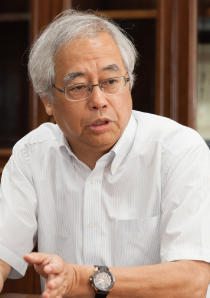
Neanderthals and Homo Sapiens differed in terms of their social and storytelling abilities
Yamagiwa Homo Sapiens may not be very genetically diversified. However, they have various body sizes and skin colors, which I think has to do with the largeness of the area they spread across and settled. But why were Homo Sapiens able to reach regions farther afield than archaic humans? I have my own theory.
Shinoda Please let me know.
Yamagiwa I believe the crucial difference between Homo Sapiens and Neanderthals laid in their social abilities. By that I mean the ability to reorganize, merge, and move between groups, which are beyond those of gorillas.
As you know, Neanderthals also had tongue bones and were able to communicate with words to some extent. However, their language could not have been as advanced as that of Homo Sapiens. The degree of sophistication of a species' language will influence its communication skills and eventually its social abilities.
Shinoda You make a very insightful observation as always.
Yamagiwa Another difference must have laid in their storytelling abilities or in whether they could say, "There may be better things waiting on that island over there. Let's build a boat and sail across." There must have been hard times, and they would have overcome these by making up stories to cherish as shared dreams to work toward. Having this ability must have enabled Homo Sapiens to reach beyond the capabilities of archaic humans.
Shinoda Yes, I agree. That reminds me of the concept of Dunbar's number.
Robin Dunbar, an anthropologist, suggested that the maximum number of people with whom one can maintain stable social relationships as a group is 150. Dunbar's number is based on a suggested correlation between cerebral neocortex size and group size. The number for Homo Sapiens is estimated at 150; for primates, at 50.
Based on this hypothesis, since the brain volumes of Homo Sapiens and Neanderthals were about the same, they should have been able to maintain communities of similar sizes.
Yamagiwa I see, so even with only a rudimentary verbal language, a group of 150 or fewer members should be able to maintain stable relationships through body language. In other words, verbal languages only begin to play crucial roles when the number of a group's members surpass 150.
Then, forming large groups back in the hunter-gatherer days, when securing food was an issue, must have been impossible. The emergence of agriculture and farming was probably what enabled humans to create groups with hundreds of members.
Shinoda That is an interesting point. Exploring how groups of humans came into existence through genome sequencing indicates strong connections between them. While repeatedly parting and reuniting, humans who started out from Africa interbred, evolving into today's humanity.
Yamagiwa So, our desire to connect with others has always been in our genes. Although we currently lean toward relying on the virtual world to connect, I believe the future requires finding more ways to connect in the real world.
Shinoda I agree. Satisfaction, fulfillment, and the joy of life only found in the real world can never be understood by artificial intelligence.
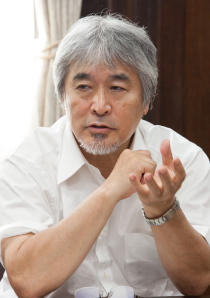
What we can do now for the future headed toward the manipulation of life
Yamagiwa The other day, I was shocked when I read Homo Deus: A Brief History of Tomorrow, Yuval Noah Harari's sequel to his worldwide best seller Sapiens: A Brief History of Humankind.
It said that humanity (Homo Sapiens) is still evolving and that someday with the development of technology, will become Godlike beings, or "homo deus" (human god). Harari says that humanity will acquire immortality, or eternal life, by becoming an inorganic life form with life engineering technologies, including genetic engineering and cyborgization.
Shinoda Medicine has developed the advanced technology to treat our pains and worries. However, future medical advancements will likely be aimed at altering our pains and worries.
Yamagiwa If genome sequencing developments begin to lean toward viewing life as algorithms, life will be considered as something that can be not only altered but also created.
Shinoda I believe that our understanding of the human body is not as thorough as we like to think, and that gene editing is not at all easy. Nevertheless, technology keeps progressing. Of course, there are negative perceptions of life manipulation as something dangerous. However, the bottom line is whether these will eventually form the majority opinion.
What we can do for the future headed toward the manipulation of life is determining where the line should be drawn between humans and inorganic life forms.
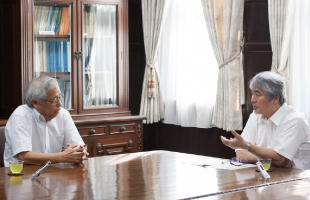
Messages for young researchers
Plan your life in 20-year increments
Yamagiwa Do the skills required of museum researchers differ from those of university researchers, since unlike universities, museums primarily welcome general visitors?
Shinoda To be able to help all kinds of visitors, museum researchers are required to have excellent presentation skills. There used to be a label for researchers that applied if they were considered useless after growing old, which was "museum material." It meant they needed to be put away in museums with others who, instead of curating exhibitions, only lived to collect items in line with their interests like their favorite butterflies.
But over the last decade, things have greatly changed. Like universities, national museums became required to manage themselves financially and survive by promoting the roles and values of museums in society.
At the same time, we also consider collecting and preserving items for future generations to be one of our core reasons for existing. Therefore, we need to balance serving our current community and cultivating future museum researchers.
Yamagiwa With not as many scientific magazines being published as before and there not being enough experts with the skills to pass cutting-edge expertise, including science, in layman's terms on to people of all ages and occupations, we hope museums cultivate not only curators but also communicators and educators.
Shinoda I agree.
On another note, the results of visitor surveys we take when planning special exhibitions usually would secure a certain number of visitors. However, that isn't what we should do for imparting knowledge. The important thing is to consider how we can interest potential visitors in coming to see what we want to show them.
The world would be a boring place, if future trends are forecasted by artificial intelligence. I believe that further pursuit of technological advances in artificial intelligence and efficiency will only reduce our possibilities by turning us into unimaginative, narrow-minded individuals with identical thoughts.
I want us to value originality, and one useful way of doing that, in my opinion, is leaving researchers alone.
Yamagiwa No one wants an unoriginal exhibition. Instead, we expect fun and surprises, which are, after all, what help our understanding.
Shinoda Researchers need to do what they think is fun.
Yamagiwa I agree. One of today's problems is the tendency for researchers to choose topics based on their likelihood of developing into a paper.
Shinoda That is absolutely true. There is a tendency to choose topics by prioritizing their chances of appealing to peer reviewers and of receiving a high journal impact factor.
Yamagiwa Researchers should remind themselves that they only live once and take up the challenge of doing what truly interests them.
Shinoda I know that young researchers today, unlike our generation, are placed under the pressure of producing results within shorter amounts of time, and I do sympathize with them. Nevertheless, I want them to take a long range view to live their lives as researchers in ways that will enable them to feel proud of themselves.
Back in my days at Kyoto University, Tsuyoshi Mori, a mathematician who taught me, said to me, "Plan your life in 20-year increments." He told me to lay my foundation as a researcher in the first 20, use the next 20 to prove myself as a researcher, and pass the baton to the next generation in the last 20.
Back then, I did not understand the significance of his words, but now I truly appreciate them and would like to pass them on.
The appeal of Kyoto University that differentiates it from the others and must be passed on lies in its cultural diversity
Yamagiwa I understand that we graduated from the same faculty, the Faculty of Science. Has what you studied at Kyoto University helped you through life?
Shinoda Kyoto University was extremely culturally diversified. Everyone I knew was a "weirdo." We all did as we pleased for four years, not being told which way to go, which became a very valuable experience.
We would spend a lot of time in our laboratory, playing go. So, the place did not feel like a laboratory. But we also studied hard, whenever we needed to. We were allowed to do as we pleased, as long as we completed our assignments. The school taught me what it meant to have freedom.
Yamagiwa Lastly, what kind of efforts do you look forward to seeing Kyoto University make in the future?
Shinoda A country cannot develop only by being well-ordered. To develop, a country needs its well-ordered state to be supported by a rich culture. While the University of Tokyo has performed its mission of cultivating bureaucrats, Kyoto University has maintained cultural diversity surrounding the ordered state to assist the country in developing a rich culture.
If Kyoto University were to lose its appeal, that would impoverish Japan's culture. Although government grants continue to decrease, I believe the University must continue to fulfill its responsibility of maintaining its cultural diversity by putting efforts into raising funds. Kyoto University needs to realize and take pride in the significant influence it has as a university.
Yamagiwa I am extremely grateful and humbled by your support. Thank you very much.
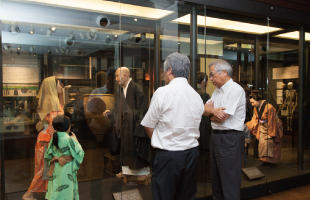 Examining models of medieval and early modern people
Examining models of medieval and early modern people
(Interview held in July 2018)
■ National Museum of Nature and Science ■
Founded in 1877 (Meiji 10), the Museum has a history longer than 140 years and is the only national museum that offers a comprehensive exhibition of natural history and the history of science and technology. It has a collection of over 4.6 million valuable items.
The exhibition comprises two parts: the "Japan Gallery" and the "Global Gallery." The Japan Gallery exhibits taxidermies of the loyal Hachiko and the Antarctic expedition dog Jiro. The Global Gallery exhibits the world's most beautifully preserved authentic fossil specimen of the Triceratops and many taxidermies of large mammals and birds. The museum also holds many events, including physics and chemistry experiments and nature observation events.
